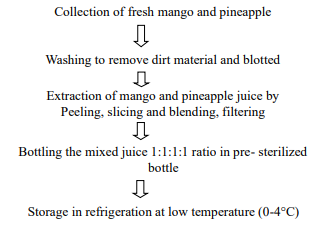
Figure 1.Flow chart for processing of mango, pineapple pulp and mixed fruit juice
Comparison of nutritional and chemical characteristics of selected mango, pineapple and mixed juice
Bikash C Sarker*and Sanchita Roy
Department of Agricultural Chemistry, Faculty of Agriculture, Hajee Mohammad Danesh Science and Technology University, Dinajpur-5200, Bangladesh
Article history: Received:18.10.2020, Accepted: 30.12.2020, Published Online: 31.12.2020
*Corresponding author:bikash@hstu.ac.bd
www.isciencepub.com
ABSTRACT
Mango and pineapple are considered the major fruits in Bangladesh and some other countries attributable to its high food values, color variability, glorious style, attractive flavor, and medicinal properties. An exploration laboratory experiment was conducted using three mango cultivars namely Surjopuri, Amrupali, Haribhangha and a pineapple cv. Calendar to examine their nutritional value and chemical characteristics from fresh fruits and their mixed juice also. The attributes like moisture, ash, fiber, pH, titrable acidity, total sugars, β-carotene, vitamin-A, vitamin-C, Ca, P, Zn and Fe were estimated from the pulp juice and its mixture. Juice of pineapple recorded the highest moisture content (90.17%). The pulp juice of mango cv. Surjopuri which contained higher amount of ash (0.118%) and fiber (0.866%),total sugars (21.65 mg/100 g), Ca (132.06 mg/100 g), P (116.19 mg/100 g), Zn (54.48 mg/100 g), respectively. The pH and titrable acidity were the highest in juice of pineapple cv. Calendar. The highest amount of β-carotene, vitamin-A and vitamin-C were in the juice of mango cv. Haribhanga and the lowest was found in pineapple cv. Calendar (0.004 mg/100 g). Among all the mineral properties the amount of zinc was the highest (64.94 mg/100 g) in Calendar and the lowest amount of mineral iron was recorded0.317%. The mixed juice contained almost intermediate values without any remarkable change of nutritional and chemical properties. The present finding infers that juice of mango cultivar cv. Surjopuri contained higher minerals and cv. Haribhanga had vitamin-A and vitamin-C which was superior to pineapple cv. Calendar. Author did not mention the mixed fruit juice results. It is suggested that people should take fresh juice considering the mineral composition, sugar and antioxidant substances present in the mango and pineapple which is essential for health benefits and medicinal values.
Keywords: Mango, minerals, mixed juice, nutritional values, pineapple, vitamin.
To cite this article: Sarker BC and Roy S. 2020. Comparison of nutritional and chemical characteristics of selected mango, pineapple and mixed juice. Intl. J. Agric. Med. Plants. 1(1): 36-44.
INTRODUCTION
Bangladesh is blessed by wide range of agro climatic conditions which have paved away to grow variety of the fruits in different seasons of the year. In different parts of country the major tropical, subtropical fruit crops are grown consecutively. A major contributor to the local fruit pulping, canning and juice industry of Bangladesh is mango (Mangifera indica L.) the most commonly processed fruit in Bangladesh. Mango ranks the third among the tropical fruits in the world with a complete production of 47.13 million tons (FAO 2017), whereas Bangladesh produced 1.16 million tons from an area of 37,830 hectares of land (BBS 2017). Mango juice is rich in carbohydrate, sugar, vitamin-C, protein and trace metals (Jahan et al. 2011). On the other hand among all the fruits produced in the country, pineapple ranks 4th in terms of total area and production (Hossain and Islam 2017). Mango is now recognized as one of the best fruits of all indigenous fruits due to its excellent flavor, attractive fragrance and beautiful shades of color, delicious taste and high nutritive value. Considering nutrient supplies, mango has considerable quantity of β-carotene antioxidant, and dietary fiber further as soluble sugars and different minerals and many other useful substances (Pal 1998). Among the main constituents of this fruit, carbohydrate and acid contribute a great deal to the food value of the fruit.
Besides major tropical and subtropical fruits like mango, the pineapple (Anana scomosus L.) is one of the most important commercial fruit crops grown in Bangladesh. It is a common fruit in Bangladesh and it contain good amount of various vitamins, carbohydrates, crude fiber, water and different minerals that is good for the digestive system and helps in maintaining ideal weight and balanced nutrition (Hossain and Islam 2017). The pineapple belongs to the family Bromeliaceae is an essential tropical fruit that is consumed fresh or in various processed form. Pineapple was reported to contain polyphenolic compounds and also retain antioxidant activity (Hossain and Rahman 2011). The antioxidant activity is provided by the compounds such as phenolics and flavonoids (Alothman et al. 2009, Danino et al. 2009). Fruit juices are liquid form of non-alcoholic product with degree of clarity and viscosity produced through pressing of fruits with or without added of sugar or carbon dioxide (Costescu et al. 2006). Pineapple which is considered as a functional drink due to its health promoting properties and has anti-inflammatory, anti-atherosclerotic, anti-aging and many other healing properties. In modern society there is a growing interest in finding new bioactive molecules contained in the plants and fruits to be used both in the food and pharmaceutical industries. The consumption of fruit juices has been increasing during the last decades because of its various health benefits and consumption of fresh fruit is often replaced by the fruit juices (Liu 2003).This work was done in a small scale by some researchers but needs more attention to study on chemical and nutritive value of the mango and pineapple cultivated in Bangladesh. The objectives were to investigate the nutritional values and chemical composition of selected cultivars of fresh mango and pineapple pulp and their comparison of nutritional values among different mango cultivars, pineapple and their mixed juice.
MATERIALS AND METHODS
The investigation was carried out in the Department of Agricultural Chemistry, Hajee Mohammad Danesh Science and Technology University, Dinajpur, Bangladesh. The tested mango cultivars were a) Surjopuri b) Amrupali c) Haribhanga and pineapple cultivar was Calendar. The fresh unripe mango and pineapple fruits were purchased as a test material from the local market in Dinajpur, Bangladesh. Triplicated samples from each cultivar were used for study purpose. Chemicals and other reagents used for the study were from chemically pure reagent grade. The sample juice was prepared following the process as below-

Figure
1.Flow chart for
processing of mango, pineapple pulp and mixed fruit juice
Determination of moisture content and ash content: Moisture content of fruit juice sample was calculated using the following equation:

Exactly
10 mL tested juice sample was taken in a cleaned, dried, accurately
weighed porcelain crucible. It was heated gently in an oven at 105oC.
Then it was transferred into muffle furnace for heating over a low
flame to prevent any loss during charring and then strongly until ash
remained followed by heating four hours at 600oC.
Then warm crucible was transferred to desiccators and weighed to
ensure complete ashing. The ash turned into almost white. This was
repeated till two consecutive weights until constant. The ash content
of tested juice was estimated by Ranganna’s (1979) method.
Determination
of fiber: The
fiber content was analyzed by adopting the procedure mentioned by
AOAC (2000). The juice sample was boiled for 30 min in 200 mL of
1.25% H2SO4 and
was filtered followed by washing. Similar process was followed for
two times. The resultant residue was dried at 110°C for two hrs
and weighed. The dried residue was ignited at 550±15°C,
cooled and reweighed. The crude fiber was calculated based on the
formula below:


Total
sugar: An aliquot
of 50 mL of the clarified, de-leaded filtrate was pipetted to a 100
mL volumetric flask. 5 mL conc. HCl and allowed to stand at room
temperature for 24 hours. It was neutralized with concentrated NaOH
solution followed by 0.1 N NaOH solution. The volume was made upto
the mark and transferred to 50 mL burette having an offset tip and
performed the titration on Fehling’s solution similar to the
procedure described in the determination of reducing sugar (AOAC
2000).
Vitamin-C: Vitamin-C acid was determined by following the method of Ranganna (1979). %Vitamin-C
![]()
Beta
carotene and vitamin-A: Beta
carotene content was estimated in mg g-1 or
mg/100mL using the following equation (Barros et
al. 2011, Igbokwe
et al. 2013).The extract was prepared using Acetone: n-Hexane (4:6)
and optical density was measured with UV-Spectrophotometer at 663 nm,
505 nm and 453 nm.
β-Carotene=0.216×A663-0.304×A505+0.452×A453 (mg/g).

Calcium,
Phosphorus, Zinc and Iron content in mango and pineapple pulp
juice: Iron
content was measured using redox titration method. The extraction was
prepared in phosphoric acid and titration was done using KMnO4 as
an oxidizing agent. Phosphorus was estimated by stannous
chloride method with the help of UV-spectrophotometer. Sulphomolybdo
blue complex was developed which shows an optimum absorption at 660
nm wave length. Calcium was estimated by complexometric method of
titration using Na2-EDTA
as a complexing agent.
RESULTS AND DISCUSSION
The ash (%) of mango and pineapple fruit juice ranged from 0.092 to 0.118% (Table 1). Surjapuri showed the highest ash (0.118%) content while Amprupali contained the lowest (0.092%) content. Among the mango cultivars studied, Surjopuri produced the highest ash % followed by Haribhanga and Amrupali. Mixed fruit juice contained intermediate (0.104%) ash content. Higher ash content indicates the higher phytochemicals which might beneficial for health by supplying vitamins, antioxidant chemicals, minerals as well as fiber.
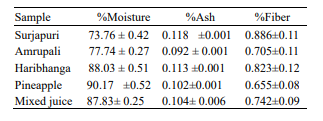
Chemical properties of mango and pineapple
pH: The pH of different fruit juice samples are shown in Figure 1. The findings exposed that pH varied from cultivar to cultivar. Figure 1 shows that the highest pH value (5.61) was found in pineapple sample and the lowest was in Haribhangha (4.71). The pH value of Amrupali, Surjapuri and mixed fruit juice were 5.14, 5.55 and 5.44 respectively. This finding was in agreement with Shafique et al. (2006) where they conducted an experiment on different mango and pineapple cultivars of Bangladesh. They found that the pH of mango varieties at mature and ripen stages varied from 3.7 to 4.2 and 4.2 to 5.4 for immature, mature and ripe mangoes, respectively. The low pH of mango juices is due to the presence of natural occurring acids or genetic make up and the standard value of pH of mango juices is ranged from 2.8 to 5.4 (Susser 2001). Frazier and Westhoff (1995) have been reported that pineapple contained a pH range of 3.7 – 4.5. Akusu et al. (2016) found that pineapple juice has a pH value of 3.97. Adubofuor et al. (2010) revealed a range of 4.82 – 4.99 for cocktail juices. In the present study, the pH of mixed juice was 5.42 which slightly higher than that of Adubofuor et al. (2010).
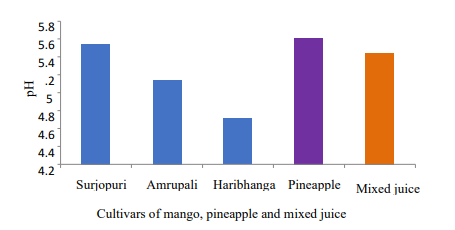
Figure
1. pH of mango,
pineapple and mixed fruit juice.

Figure
2.Titrable acidity of
mango, pineapple and mixed fruit juice
Titrable acidity (TA): Acidity of the juice of mango, pineapple and mixed fruit of the present study was varied from 0.53% to 0.81%. Figure 2 shows that the highest acidity value (0.81%) was found in pineapple juice and the lowest value (0.53%) was found in Haribhanga pulp juice. The titrable acidity values of Surjopuri, Amrupali and pineapple samples were 0.67, 0.72 and 0.73%, respectively). The mixed fruit juice had 0.73% regarding titrable acidity. The variability of titrable acidity are significantly affected by the rate of metabolism especially respiration which consumed organic acid and thus declined acidity during the storage. Hossain et al. (2014) delineated the changes in TA of mango fruit with the increase of storage time in different temperatures. Kareem and Adebowale (2007) reported that the dominant acid in orange juice is citric acid. Ndife et al. (2013) also observed the same reversed case between pH and acidity values. This indicates that juices get more acidic at a decreased pH value.
Total sugar: Figure 3 shows the total sugar content in the mango, pineapple and mixed juice. The lowest total sugar was in pineapple cv. Calendar and the highest value was found in mango cv. Surjapuri. The highest value of total sugar was 21.65% in juice of Surjopuri cultivar than those of other two cultivars of mango and one pineapple cultivar. The total sugar content of the juice of pineapple cv. Calendar and mixed juice was 7.45 and 15.0%, respectively. Genetic variation and environmental factor like temperature could have possible reason for the cause of differences in sugar content. Higher sugar content in mango comparison to pineapple is important for food values and taste. It supply more energy for the growth and living purpose while negatively considered for dietary patients due to risk of increasing diabetes mellitus.

Figure
3. Total sugar of
mango, pineapple and mixed fruit juice
Antioxidant properties:β-carotene: β-carotene content from tested juice samples of different cultivars of mango and pineapple was in the range of 0.0027-0.0053 mg/100g. Figure 4 shows that the maximum value of β-carotene was found in the juice of Haribhanga while pineapple cv. Calendar had the minimum content. The Surjopuri, Amrupali and mixed juice contained 0.0041, 0.0052 and 0.0036 mg β-carotene content per 100g sample, respectively. The mixed juice prepared from Haribhanga and Calendar showed intermediate amount of β carotene and was 0.00363 mg/100g.It has been reported that the increase in total carotenoids during maturity has been considered as ripening index and harvest indicator; that is, the cultivars Sensation and Xiangya grown in China showed significantly higher total carotenoid content values in peels than in pulp; on the contrary, the variety Keitt also grown in China exhibited an adverse result (Hu et al. 2018).
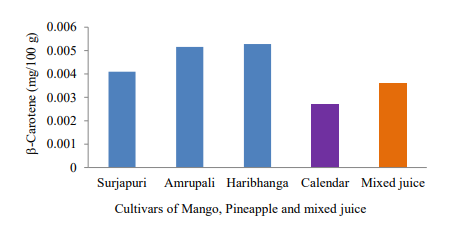
Figure
4. -Carotene of mango, pineapple and mixed
fruit juice
Vitamin-A: Vitamin-A content was observed to range from 0.0045to 0.0088 (mg/100 g) in the studied mango and pineapple juice and their mixed samples. The highest amount of vitamin-A was found in mango cv. Haribhanga while the lowest amount was in pineapple cv. Calendar. The mixed juice showed 0.0061 mg/100g FW. The content of vitamin A in the fruit varies from 1,000 to 6,000 IU (Matheyambath et al. 2016).
Thus, mango consumption is very important, especially for those regions where there is a deficiency of vitamin A (Muoki et al. 2009). Vitamin C and vitamin A are dominant, suggesting that regular consumption of mango and pineapple fruits can provide the necessary dietary requirements of these vitamins (WHO/FAO, 2003).
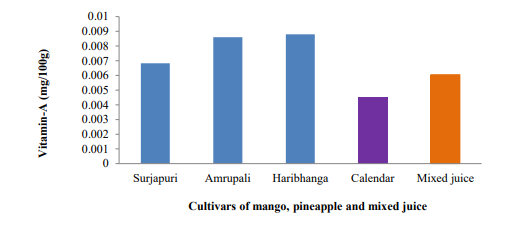
Figure
5. Vitamin-A of mango, pineapple and mixed fruit
juice
Vitamin-C: There was a variability of vitamin-C observed among different mango cultivars, pineapple and mixed juices. Vitamin-C of different juices ranged from 5.00 to 50.83 mg/100 g. Figure 6Shows that the highest vitamin-C content was found in Haribhangha sample and the lowest was found in mixed juice. Varietal difference might be the cause of difference in vitamin-C.
In the present study, pineapple had the lower vitamin-C than those of mango juice. The antioxidant properties of mango were remarkably higher due to presence of higher content of vitamin-C. Enormous variations exist in vitamin-C content, fluctuating from 9.79 to 186 mg/100 g of mango pulp were reported by many renowned researchers (Manthey and Perkins-Veazie 2009, Wongmetha and Ke 2012, Matheyambath et al. 2016, USDA 2018).
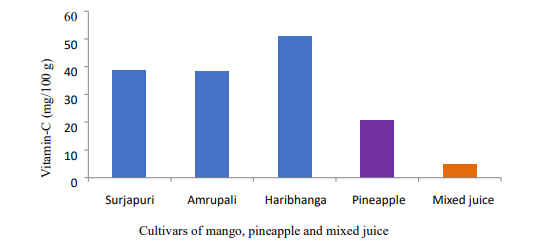
Figure
6. Vitamin-C of
mango, pineapple and mixed fruit juice
Mineral Nutrients
Iron content: Iron content of different cultivars of mango and pineapple was found in the range of 0.31% to 0.89%. Figure 7 shows that the maximum value of iron was found in Surjopuri sample and the minimum value was found in Haribhangha. Islam et al. (2017) also found in a lower amount of iron in different varieties of pineapple. This different was due to different varietal characters.
Table 2 shows the mineral composition of Calcium, Phosphorus and Zinc of mango, pineapple and mixed juice. Surjopuri juice contained the highest amount of Ca, P and Zn content. Presence of higher Ca, P and Zn is necessary for better nutritional point of view. Higher Ca content is important for the bone formation and P for energy and many biochemical reactions. Mango juice should have crucial for human growth and development. Zn is a micronutrient present at trace amount plays a vital role for metabolic activity especially for disease resistance for baby and old person. So, Surjopuri pulp juice is better than those of mango cultivars regarding Zn nutrition.
The major essential minerals contribution in the juice prepared from mango and pineapple pulp were Ca and P while the levels of Zn and Fe were the lowest micronutrients in the study. The pulp juice of mango cultivars had the higher minerals than that of pineapple cultivar in the following order of Ca>P>Zn>Fe.
Table 2.Mineral composition of three mango cultivars, pineapple and mixed juice
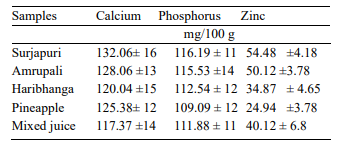
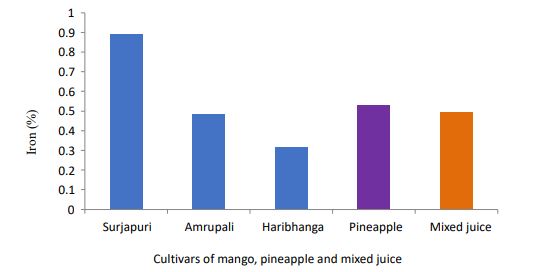
Figure
7. Iron content
(mg %) of mango,pineapple and mixed fruit juice.
CONCLUSION
Mango and pineapple are valuable major fruits considering a nutritional point of view, providing fiber, sugar, antioxidants (vitamin-A, vitamin-C, -carotene), mineral nutrients (Ca, P, Zn and Fe) and organic acids. Mango contained higher amount of fiber, -carotene, vitamin-A, vitamin-C, minerals and some other parameters than that of pineapple. The mixed juice sample also had the richest amount of ash content but there was no marked property interesting in the present study. The studied pineapple had the highest pH value indicating presence of more organic acids. The most interesting is that the pulp juice of mango cv. Haribhanga which had a higher amount of β-carotene, vitamin-A and vitamin-C. The phytochemical properties of
tested mango juices is better compared to pineapple pulp and mixed juice which might be used in domestic and processing industries in our country and can help to improve our nutritional demand.
REFERENCES
Adubofuor J, Amankwah EA, Arthur BS and Appiah F. 2010. Comparative study related to physico-chemical properties and sensory qualities of tomato juice and cocktail juice produced from oranges, tomatoes and carrots. African Journal of Food Science. 4(7): 427-433.
Akusu MO, Kiin-Kabari BD and Ebere OC. 2016. Quality characteristics of orange/pineapple fruit juice blends. American Journal of Food Science and Technology. 4(2): 43-47.
Alothman M, Bhat R and Karim AA. 2009. Antioxidant capacity and phenolic content of selected tropical fruits from Malaysia, extracted with different solvents. Food Chemistry. 115: 785-788.
AOAC. 2000. Officials methods of analysis of the association of official analytical chemist. International 17th Ed. Washington, D.C.P. 36.
Barros L, Cabrita L, Boas MV and Carvalho AM. 2011. Chemical, biochemical and electrochemical assays to evaluate phytochemicals and antioxidant activity of wild plants. Food Chemistry. 127: 1600-108.
BBS. 2017. Yearbook of Agricultural Statistics of Bangladesh. Bangladesh Bureau of Statistics, Ministry of Planning, Dhaka, Bangladesh, P.124.
Costescu C, Parvu D and Rivis A. 2006. The determination of some physicochemical characteristic for orange, grapefruit and tomato juices. Journal of Agro Alimentary Processes and Technologies. 12(2): 429-432.
Danino O, Gottlieb HE, Grossman S and Bergman M. 2009. Antioxidant activity of 1, 3 dicaffeoylquinic acid isolated from Inulaviscosa. Food Research International.42 (9): 1273-1280.
FAO. 2017. FAO production yearbook. Food and Agriculture Organization Rome, Italy. 56: 145-146.
Frazier WC and Westhoff DC. 1995. Food Microbiology, 4th edition, McGraw Hill, New Delhi. PP. 83-98.
Hossain MA and Rahman SMM. 2011. Total phenolics, flavonoids and antioxidant activity of tropical fruit pineapple. Food Research International. 44: 672-676.
Hossain MA, Rana MM, Kimura Y and Roslan HA. 2014. Changes in biochemical characteristics and activities of ripening associated enzymes in mango fruit during the storage at different temperatures. Hindawi Publishing Corporation BioMed Research International Article ID 232969. https://dhakatribune.com/business/2018/06/22/mango-prices-low-in-rajshahifarmers-alarmed
Hossain MF and Islam MA. 2017. Pineapple production status in Bangladesh. Agriculture, Forestry and Fisheries. 6(5): 173-177. doi: 10.11648/j.aff.20170605.15.
Hu K, Dars AG, Liu Q, Xie Band and Sun Z. 2018. Phytochemical profiling of the ripening of Chinese mango (Mangifera indica L.) cultivars by real-time monitoring using UPLC–ESI–QTOF-MS and its potential benefits as prebiotic ingredients.Food Chemistry. 256: 171–180. doi: 10.1016/j. foodchem.2018.02.014
Igbokwe GE, Aniakor GC and Anagonye CO. 2013. Determination of β–Carotene and vitamin C content of fresh green pepper (Capsicum annnum) fresh red pepper (Capsicum annum) and fresh tomatoes (Solanum lycopersicum) fruits.The Bioscientist Journal. 1(1): 9–93. https://bioscientistjournal.com/index.php/The_Bioscientist/article/view/22
Islam D, Akand AH and Rahman MATM. 2017. A Comparativestudy on the proximate composition and nutrient analysis of three varieties of pineapples (Annana scomosus) grown in Bangladesh. IOSR Journal of Environmental Science, Toxicology and Food Technology. 11(6): 43-45.
Jahan S, Gosh T, Begum M and Saha BK. 2011. Nutritional profile of some tropical fruits in Bangladesh: specially anti-oxidant vitamins and minerals. Bangladesh Journal of Medical Science. 10(2): 95-103.
Kareem SO and Adebowale AA. 2007. Clarification of orange juice by crude fungal pectinase from citrus peel. Nigerian Food Journal. 25(1): 130-137.
Liu R. 2003. Health benefits of fruit and vegetables are from additive and synergistic combinations of phytochemicals. American Journal of Clinical Nutrition. 78(3): 517S-520S.
Manthey JA and Perkins-Veazie P. 2009. Influences of harvest date and location on the levels of beta-carotene, ascorbic acid, total phenols, in vitro antioxidant capacity, and phenolic profiles of five commercial varieties of mango (Mangifera indica L.).Journal of Agricultural and Food Chemistry. 57(22): 10825-30. doi: 10.1021/jf902606h
Matheyambath AC, Subramanian J and Paliyath G. 2016. Mangoes reference module in food science, in Encyclopedia of food and health. Eds. BC Paul and F F Told (Switzerland: Elsevier).PP. 641–645. doi: 10.1016/ B978-0-12-384947-2.00442-6
Muhmadzadeh J, Sadeghi-Mahoonak AR, Yaghbani M and Aalami M. 2010. Extraction of pectin from sunflower head residues of selected Iranian cultivars.World Applied Sciences Journal. 8: 21-24.
MuokiPN, Makokha AO, Onyango CA and Ojijo NK. 2009. Potential contribution of mangoes to reduction of vitamin A deficiency in Kenya. Ecology of food and Nutrition. 48: 482–498. doi: 10.1080/0367024090330860
NdifeJ, Awogbenja D and Zakari U. 2013. Comparative evaluation of the nutritional and sensory quality of different brands of orange-juice in Nigerian market.African Journal of Food Science. 7(12): 479-484.
Nagata M and Yamashita I. 1992. Simple method for simultaneous determination of chlorophyll and carotenoids in tomato fruit.Journal of Japanese Society of Food Science and Technology. 39: 925–928.
Pal RK. 1998. Ripening and rheological properties of mango as influenced by ethereal and carbide. Journal of Food Science and Technology. 35(4): 358- 360.
Ranganna S. 1979. Manual of analysis of fruits and vegetables products. Tata McGrwaw Hill Publishig Co. Ltd., New Dehli, India, p. 312.
Shafique MZ, Ibrahim M, Helali MOH and Biswas SK. 2006. Studies on the physiological and biochemical composition of different mango cultivars at various maturity levels.Bangladesh Journal of Scientific and Industrial Research. 41(1-2): 101-108.
Susser A. 2001. The Great Mango Book: A Guide with Recipes. Ten Speed Press. ISBN: 978-1- 58008-204-4.
USDA (United States Department of Agriculture), Agricultural Research Service. 2018. USDA national nutrient database for standard reference, release 1 April, Nutrient Data Laboratory Home Page, https:// ndb.nal.usda.gov/ndb/.
WHO/FAO. 2003. Diet, nutrition and prevention of chronic diseases. Report of a join WHO/FAO expert consultation (WHO technical report series 916.World Health Organization, Geneva, Switzerland, PP. 1-149.(http://apps.who.int/ iris/bitstream/10665/42665/1/WHO_TRS_916.pdf?ua=1)
Wongmetha O and Ke LS. 2012. The quality maintenance and extending storage life of mango fruit after postharvest treatments. International Journal of Agricultural and Biosystems Engineering. 6(9): 798-803.